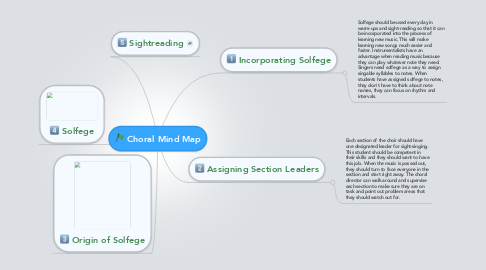Choral Mind Map
by Teresa Hargrove

1. Sightreading
2. Solfege
3. Origin of Solfege
4. Incorporating Solfege
4.1. Solfege should be used every day in warm-ups and sight-reading so that it can be incorporated into the process of learning new music. This will make learning new songs much easier and faster. Instrumentalists have an advantage when reading music because they can play whatever note they need. Singers need solfege as a way to assign singable syllables to notes. When students have assigned solfege to notes, they don't have to think about note names, they can focus on rhythm and intervals.
5. Assigning Section Leaders
5.1. Each section of the choir should have one designated leader for sight-singing. This student should be competent in their skills and they should want to have this job. When the music is passed out, they should turn to face everyone in the section and start right away. The choral director can walk around and supervise each section to make sure they are on task and point out problem areas that they should watch out for.


